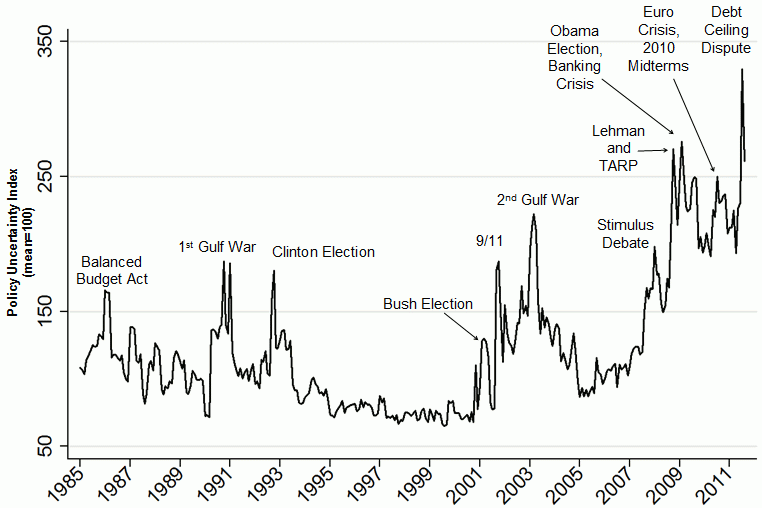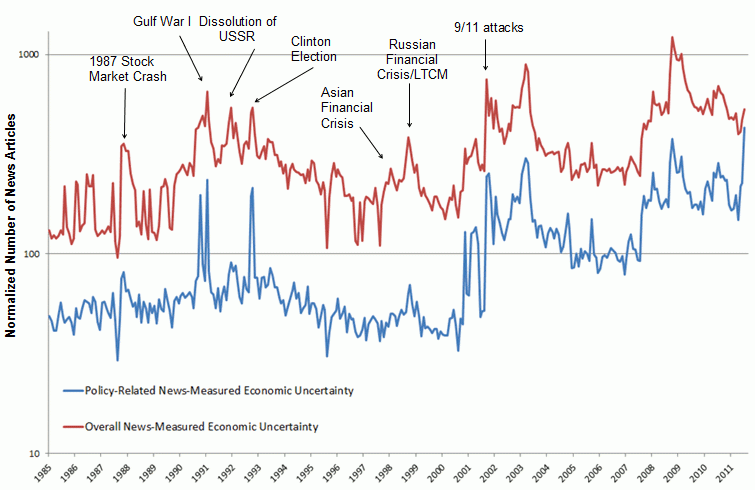The most striking thing about recent stock-market volatility is that politicians are making the news. Policymaker actions and statements about bailouts, budgets and regulatory reforms are driving the stock-market gyrations (Calvo 2009).
This is not normal. Before the financial crisis of 2008, the stock market usually moved in response to economic news. Strong GDP and employment figures would send the markets soaring. Poor corporate earnings would send the markets crashing.
But today, all eyes are on the policymakers. Unfortunately, they cannot agree, generating massive economic uncertainty. In fact, according to our new index, economic policy uncertainty is now close to its all-time high (see Figure 1). This policy uncertainty is a key factor stalling the recovery and threatening a return to recession.
Figure 1. Index of US economic policy uncertainty
Source: Baker, Bloom and Davis (2011). Data available online. Notes: Index of policy-related economic uncertainty composed of 4 series: monthly news articles containing uncertain or uncertainty, economic or economy, and policy relevant terms (scaled by the smoothed number of articles containing ‘today’); the number of tax laws expiring in coming years, and a composite of interquartile ranges for quarterly forecasts of federal government expenditures and 1-year CPI from the Philadelphia Fed Survey of Forecasters. Weights: 1/2 Google News, 1/6 tax expirations, 1/6 CPI disagreement, 1/6 Federal expenditures disagreement after each index normalized to have a standard-deviation of 1. Google query run August 11, 2011, updated Sept 25. Iindex normalized to 100 mean before 2000.
Measuring economic policy uncertainty
We constructed a new index of policy uncertainty by combining three types of information: the frequency of newspaper articles that reference economic uncertainty and the role of policy, the number of federal tax code provisions set to expire in coming years, and the extent of disagreement among forecasters about future inflation and government purchases of goods and services.
Our index shows sharp spikes in economic policy uncertainty around major elections, wars, and the 9/11 terrorist attacks. More recently, it spiked sharply after the Lehman bankruptcy in September 2008 and passage of the TARP legislation. It has remained high ever since.
Of course, policy uncertainty could be high simply because general economic uncertainty is also high. To test this view, we use Google News listings to construct a broad index of economic uncertainty and a narrower index focused squarely on policy uncertainty. Comparing these two indexes (Figure 2) reveals several episodes that involve large spikes in economic uncertainty but little or no jump in policy uncertainty. Examples include the Asian Financial Crisis of 1997 and several bouts of recession fears in the second half of the 1980s.
In short, the data refute the view that economic uncertainty necessarily breeds policy uncertainty.
Figure 2. Economic policy uncertainty and overall economic uncertainty
Source: Baker, Bloom and Davis (2011). Data available online. Notes: Overall news-based economic uncertainty index composed of monthly number of news articles containing uncertain or uncertainty as well as economic or economy (scaled by the smoothed number containing ‘today’). Policy Index set such that monthly average value is 100. Index covers January 1985-July 2011. Axis shown as a log scale. Query run on August 11, 2011. Smoothed Ratio is the Hodrick-Prescott trend for the ratio of the levels of policy-related economic uncertainty to overall economic uncertainty.
Why is policy uncertainty now so high?
To identify the drivers of policy uncertainty, we drilled into Google News listings and quantified the mix of factors at work. Several factors underlie the high levels of policy uncertainty in 2010 and 2011, but monetary and tax issues predominate.
One clear example involves the Bush-era income tax cuts originally set to expire at the end of 2010. Democrats and Republicans adopted opposing positions about whether to reverse these tax cuts. Rather than resolve the uncertainty in advance, Congress waited till the final hour before deciding to extend the tax cuts. Recent moves in the US Senate to increase tariffs on Chinese imports threaten to set off a trade war. In Europe, continuing debates over potential bailouts for countries and banks contribute to a climate of policy uncertainty.
Why is policy uncertainty harmful?
When businesses are uncertain about taxes, health care costs and regulatory initiatives, they adopt a cautious stance. Because it is costly to make a hiring or investment mistake, many businesses naturally wait for calmer times to expand. If too many businesses wait to expand, the recovery never takes off. Weak investments in capital goods, product development, and worker training also undermine longer-run growth.
How much near-term improvement could we expect from a stable, certainty-enhancing policy regime? We use simple identifying assumptions and vector auto regressions, for which Chris Sims won this year’s Nobel prize, to estimate the effects of economic policy uncertainty (Marimon 2011).
Our VAR estimates for the US (Figure 3) suggest that restoring 2006 levels of policy uncertainty could increase industrial production by 4% and employment by 2.5 million jobs over 18 months. Not enough to create a booming economy, but a big step in that direction.
Figure 3. US production and employment after a policy uncertainty shock
Source: Baker, Bloom and Davis (2011). Notes: This shows the impulse response function for Industrial Production and employment to a 124-unit increase in the policy-related uncertainty index, the increase from 2006 (the year before the current crisis) until the first 8 months of 2011. The central (black) solid line is the mean estimate while the dashed (red) outer lines are the one-standard-error bands. Estimated using a monthly Cholesky vector auto regression of the uncertainty index, log S&P 500 index, federal reserve funds rate, log employment, log industrial production and time trend. Data from 1985 to 2011.
References
Baker, Bloom and Davis (2011), “Measuring Economic Policy Uncertainty”, Chicago & Stanford mimeo.
Calvo, Guillermo (2009), “Triple time-inconsistent policies”, VoxEU.org, 31 August.
Marimon, Ramon (2011), “Nobel Prize: Lessons learned from Sargent and Sims”, VoxEU.org, 16 October.







